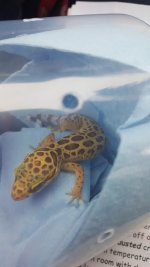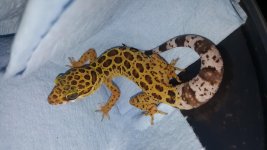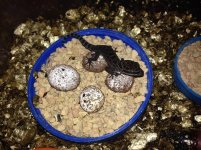Elizabeth Freer
Well-known member
My dream IS alive!  Two hatchlings popped out of their eggs on Valentine's Day 2017!
Two hatchlings popped out of their eggs on Valentine's Day 2017!
Click: https://www.geckosunlimited.com/community/threads/84864/
For details on my entire crew click: http://www.geckosunlimited.com/community/bent-toed-bow-fingered-geckos-cyrtodactylus/82519-14-february-2017-2-cyrtodactylus-zebraicus-hatchlings.html
Click: https://peerj.com/articles/5575/
~ ~ ~ ~ ~ ~ ~ ~ ~ ~ ~ ~ ~ ~ ~ ~ ~ ~ ~ ~ ~ ~ ~ ~ ~ ~ ~ ~ ~ ~ ~ ~ ~ ~ ~ ~ ~ ~ ~ ~ ~ ~ ~ ~ ~ ~ ~ ~ ~ ~ ~ ~ ~ ~ ~ ~ ~ ~
UPDATES
female ID4's hatchlings : female ID2's hatchlings = 15 : 7
females : males = 13 : 8
+ hatchling #1: 14 February 2017
16 July 2017 "wellness" checks on hatchlings #1 and #2. They are growing like weeds and seem extremely healthy! :yahoo:
7 May 2017 weights @ 2.75 months old
#1 = 2.0 grams
#2 = 2.1 grams
16 July 2017 @ 5 months old
#1 = 4.2 grams
#2 = 4.2 grams
13 August 2017 @ 6 months old
#1 = 5.6 grams
#2 = 5.3 grams
1 Oct 2017 @ 7.5 months old
#1 = 7.0 grams
#2 = 6.9 grams
14 Dec 2017 @ 10 months old
#1 = 7.1 grams
#2 = 7.6 grams
15 Feb 2018 @ 12 months old
#1 = 8.4 grams
#2 = 8.3 grams
26 May 2018 @ 15.5 months old
#1 = 8.8 grams
#2 = 9.0 grams
16 October 2018 @ 20 months old
#2 = 10.5 grams -- gravid with 2 infertile eggs
28 October 2018 @ 20.5 months old
#1 = 8.9 grams
Click: https://www.geckosunlimited.com/community/threads/84864/
For details on my entire crew click: http://www.geckosunlimited.com/community/bent-toed-bow-fingered-geckos-cyrtodactylus/82519-14-february-2017-2-cyrtodactylus-zebraicus-hatchlings.html
Click: https://peerj.com/articles/5575/
~ ~ ~ ~ ~ ~ ~ ~ ~ ~ ~ ~ ~ ~ ~ ~ ~ ~ ~ ~ ~ ~ ~ ~ ~ ~ ~ ~ ~ ~ ~ ~ ~ ~ ~ ~ ~ ~ ~ ~ ~ ~ ~ ~ ~ ~ ~ ~ ~ ~ ~ ~ ~ ~ ~ ~ ~ ~
In September 2016 I had 2.2. However, both new females were mated with Derek Dunlop's then 5 yo male. In September 2016 my second male was too young to breed.
Now I have 3.2.
UPDATES
- 21/22 viable geckos hatched from these 1.2 Cpzs from 14 Feb 2017 through 20 January 2018!
female ID4's hatchlings : female ID2's hatchlings = 15 : 7
females : males = 13 : 8
- ID2 females = 4
- ID2 males = 2
+ hatchling #1: 14 February 2017
- Mom = ID4
- Light vertical stripe within dark horizontal band at base of head (neck)
- White tail bands: 9 (including tip)
- FEMALE - sexed on 20 Feb 2018
- 28 October 2018 weight = 8.9 grams
- 31 October 2018 ~~ Jm

- /\ Age at photo: 20.5 months
- Mom = ID4
- Light vertical stripe within dark horizontal band at base of head (neck)
- FEMALE - sexed on 20 Feb 2018
- On 20 Feb 2018 still has somewhat lighter colored body
- 16 October 2018 weight = 10.5 grams ---> gravid with 2 infertile eggs
16 July 2017 "wellness" checks on hatchlings #1 and #2. They are growing like weeds and seem extremely healthy! :yahoo:
7 May 2017 weights @ 2.75 months old
#1 = 2.0 grams
#2 = 2.1 grams
16 July 2017 @ 5 months old
#1 = 4.2 grams
#2 = 4.2 grams
13 August 2017 @ 6 months old
#1 = 5.6 grams
#2 = 5.3 grams
1 Oct 2017 @ 7.5 months old
#1 = 7.0 grams
#2 = 6.9 grams
14 Dec 2017 @ 10 months old
#1 = 7.1 grams
#2 = 7.6 grams
15 Feb 2018 @ 12 months old
#1 = 8.4 grams
#2 = 8.3 grams
26 May 2018 @ 15.5 months old
#1 = 8.8 grams
#2 = 9.0 grams
16 October 2018 @ 20 months old
#2 = 10.5 grams -- gravid with 2 infertile eggs
28 October 2018 @ 20.5 months old
#1 = 8.9 grams




















